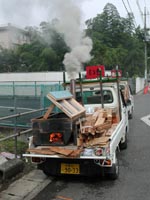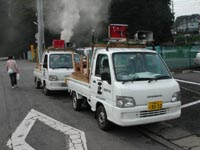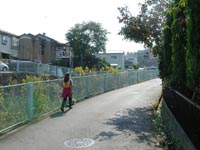| Kakio | |
|
Fall 2002 Living on the suburban frontier outside of Tokyo | |
|
Kakio Context West of Tokyo might be hip, but we live past that. We live where crazed clusters of chirping crickets crowd out mechanical whirring and buzzing noises. Where neon lights can't be sighted from the window, but actual bands of trees stand clumped in the distance, past grassy fields with no decided purpose.
Thanks to a friend of Jane's mother, we were offered the chance to live in an apartment in a building slated for demolition in four or five years. The apartments are aged perhaps, lacking some modern conveniences. It's a feeling of living somewhere more decidedly "modern" Japanese, in the same way an mid-20th century apartment in the United States might feel more decidedly "modern" American; not the post-modern flattened out efficiency increasing popular and universal in middle-class lodgings worldwide. Here, the water is heated by a propane-fueled water heater above the sink. Turn the gas on (or leave it on always, as we do, perhaps foolishly), then turn the heater on, and you get hot water. Same with the bathtub - turn on a hot water heater when you're ready to run the bath. Coming from modern living in North America, I'm accustomed to the technology of water heating being hidden from me. Similarly, I'm used to being able to sit down when I use the toilet.


| |
| toileting | |
justin's links by justin hall: contact

